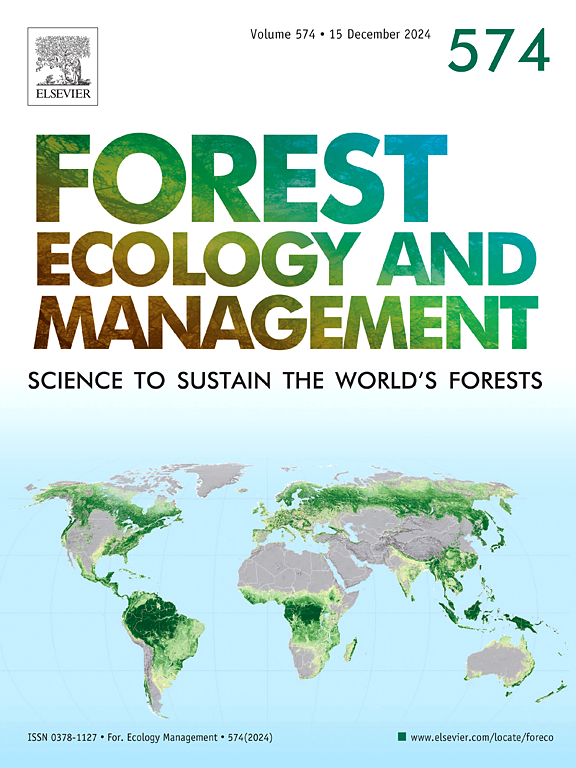Effect of bark beetle outbreak and salvage logging on tree-related microhabitats in Białowieża Forest
IF 3.7
2区 农林科学
Q1 FORESTRY
引用次数: 0
Abstract
Tree related microhabitats (TreMs) are key resources for forest biodiversity. Natural disturbances, such as bark beetle outbreaks, can influence forest structure and stand properties, potentially altering the composition of TreM communities. The removal of dead and damaged trees, often conducted after forest disturbances (salvage logging), further modifies the forest structure with potential consequences for TreMs. However, the effect of both disturbance and post-disturbance management on TreM communities in temperate lowland forests remains poorly understood. We assessed TreMs in 44 plots across three habitat types in a bark beetle-disturbed landscape of Białowieża Forest, NE Poland: unaffected areas, disturbed areas left unmanaged, and disturbed areas subjected to salvage logging with partial tree retention. Bark beetle disturbance increased the richness of three TreM groups (i.e., cavities, tree injuries, and fungi/slime moulds) as well as the abundance of seven individual TreMs, most of which were associated with tree injuries. Despite the significant retention (i.e., all living trees and 10 % of dead trees), salvage logging led to a decline in TreMs at the stand level compared to both unsalvaged disturbed and unaffected stands. In summary, the bark beetle outbreak positively impacted TreM communities at the stand level, while salvage logging reversed this effect. Based on our findings, we recommend limiting (excluding, if possible) salvage logging operations in forests managed primarily for biodiversity to enhance their provision of tree-related microhabitats for a diverse range of species. We also recommend including TreM surveys in the tree selection process during salvage logging operations.
树皮甲虫爆发和挽救性砍伐对 Białowieża 森林中与树木有关的微生境的影响
林木相关微生境是森林生物多样性的重要资源。自然干扰,如树皮甲虫的爆发,可以影响森林结构和林分特性,潜在地改变TreM群落的组成。通常在森林受到干扰(打捞性采伐)后进行的枯死和受损树木的移除,进一步改变了森林结构,对trem有潜在的影响。然而,干扰和干扰后管理对温带低地森林中TreM群落的影响仍然知之甚少。我们评估了波兰东北部Białowieża森林树皮甲虫干扰景观的3种栖息地类型的44个样地的trem:未受影响的地区,未管理的干扰地区,以及遭受部分树木保留的打捞性采伐的干扰地区。树皮甲虫干扰增加了3个TreM类群(即蛀洞、树害和真菌/黏菌)的丰富度以及7个TreM个体的丰富度,其中大部分与树害有关。尽管保留了大量的树木(即所有的活树和10. %的死树),但与未被砍伐的受干扰和未受影响的林分相比,回收采伐导致林分水平上的trem下降。综上所述,树皮甲虫的爆发对林分水平的TreM群落产生了积极的影响,而回收采伐则逆转了这种影响。根据我们的研究结果,我们建议限制(如果可能的话,排除)主要是为了生物多样性而管理的森林的补救性伐木作业,以增强它们为各种物种提供与树木相关的微栖息地。我们还建议在打捞采伐作业的树木选择过程中包括TreM调查。
本文章由计算机程序翻译,如有差异,请以英文原文为准。
求助全文
约1分钟内获得全文
求助全文
来源期刊

Forest Ecology and Management
农林科学-林学
CiteScore
7.50
自引率
10.80%
发文量
665
审稿时长
39 days
期刊介绍:
Forest Ecology and Management publishes scientific articles linking forest ecology with forest management, focusing on the application of biological, ecological and social knowledge to the management and conservation of plantations and natural forests. The scope of the journal includes all forest ecosystems of the world.
A peer-review process ensures the quality and international interest of the manuscripts accepted for publication. The journal encourages communication between scientists in disparate fields who share a common interest in ecology and forest management, bridging the gap between research workers and forest managers.
We encourage submission of papers that will have the strongest interest and value to the Journal''s international readership. Some key features of papers with strong interest include:
1. Clear connections between the ecology and management of forests;
2. Novel ideas or approaches to important challenges in forest ecology and management;
3. Studies that address a population of interest beyond the scale of single research sites, Three key points in the design of forest experiments, Forest Ecology and Management 255 (2008) 2022-2023);
4. Review Articles on timely, important topics. Authors are welcome to contact one of the editors to discuss the suitability of a potential review manuscript.
The Journal encourages proposals for special issues examining important areas of forest ecology and management. Potential guest editors should contact any of the Editors to begin discussions about topics, potential papers, and other details.
 求助内容:
求助内容: 应助结果提醒方式:
应助结果提醒方式:


